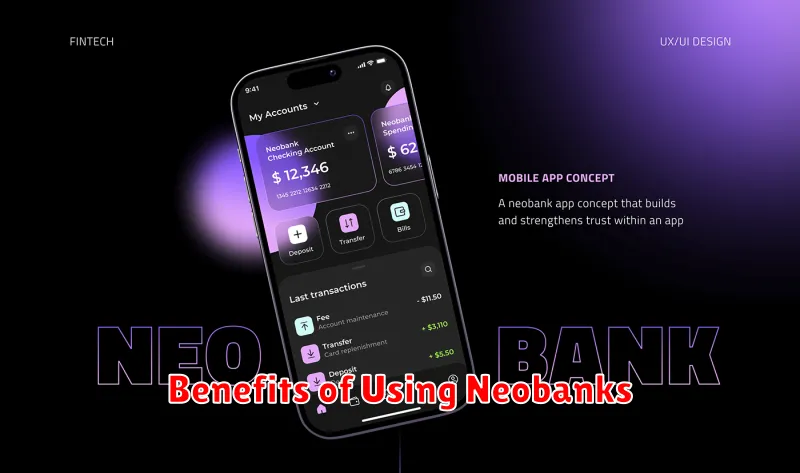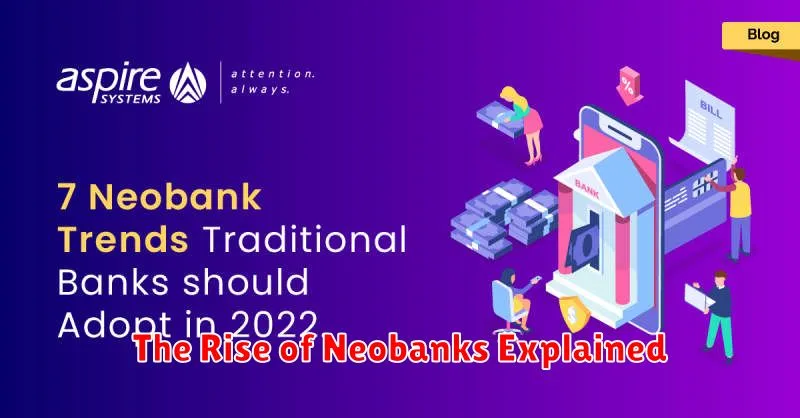The financial landscape is rapidly evolving, and at the forefront of this transformation are neobanks. These digital-first banking institutions are challenging traditional banking models, offering innovative services and streamlined experiences that resonate with today’s tech-savvy consumers. Understanding the rise of neobanks is crucial for anyone interested in the future of finance, from seasoned investors to everyday banking customers. This article will delve into the factors driving the growth of neobanks, exploring their advantages, disadvantages, and potential impact on the banking industry as a whole.
Driven by advancements in technology and shifting consumer preferences, neobanks are disrupting the financial services industry. They offer a compelling alternative to traditional banks, often boasting lower fees, higher interest rates on savings accounts, and user-friendly mobile apps. But what exactly are neobanks, and how do they differ from traditional banks? This article will explore the key features of neobanks, examining their regulatory landscape, target audience, and the competitive advantages that are propelling their growth.
What Is a Neobank?
A neobank is a digital bank that operates exclusively online without traditional physical branch networks. They offer banking services through mobile apps and web platforms, providing customers with 24/7 access to their accounts.
While some neobanks operate independently, others are divisions or partners of established traditional banks. This allows them to leverage the existing banking infrastructure while focusing on innovative digital solutions.
Neobanks typically offer a range of services similar to traditional banks, including checking and savings accounts, money transfers, and debit/credit cards. They often differentiate themselves by providing personalized financial management tools, lower fees, and streamlined user experiences.
Key Differences from Traditional Banks
Neobanks distinguish themselves from traditional banks in several key ways. Primarily, neobanks operate exclusively online, without physical branch locations. This digital-first approach allows for lower overhead costs, often translating to reduced fees for customers.
Another significant difference lies in their product focus. While traditional banks offer a broad range of financial products, neobanks often specialize in specific services, such as checking accounts, money transfers, or budgeting tools. This targeted approach allows them to streamline their offerings and provide a more user-friendly experience, particularly through mobile apps.
Regulation also differentiates the two. Traditional banks are fully licensed institutions subject to stringent regulatory oversight. Neobanks, however, may operate under different regulatory frameworks depending on their specific business model. Some partner with traditional banks to leverage their existing licenses, while others obtain their own specialized licenses.
Benefits of Using Neobanks

Neobanks offer several advantages over traditional banking institutions. A key benefit is their lower fees. They often eliminate monthly maintenance fees, overdraft fees, and international transaction fees, resulting in cost savings for customers.
Higher interest rates on savings accounts are another attractive feature. Because neobanks have lower overhead costs, they can pass on these savings to customers in the form of increased interest earnings.
Convenience and accessibility are also significant advantages. Neobanks operate primarily through mobile apps, providing 24/7 access to banking services from anywhere. Features like mobile check deposit and instant money transfers contribute to a seamless banking experience.
Furthermore, neobanks often offer innovative budgeting and financial management tools within their apps. These tools empower users to track spending, set financial goals, and manage their finances effectively.
How They Ensure Security
Security is a critical concern for any financial institution, and neobanks understand this. While not possessing physical branches, they employ various measures to protect customer funds and data.
Multi-Factor Authentication (MFA) is a standard practice. This typically involves requiring more than just a username and password to access accounts, such as a one-time code sent to a registered mobile device.
Biometric authentication, such as fingerprint or facial recognition, is also frequently employed for added security.
Neobanks leverage encryption to protect data both in transit and at rest. This means sensitive information is encoded, making it unintelligible to unauthorized parties.
Furthermore, many neobanks are regulated by the same authorities as traditional banks and are required to adhere to similar security standards and compliance regulations. They often partner with established security firms for regular audits and penetration testing to identify and address vulnerabilities.
Popular Neobanks Worldwide
Several neobanks have gained significant traction globally, offering diverse services and catering to various customer segments. Their popularity stems from factors such as user-friendly interfaces, personalized experiences, and often lower fees compared to traditional banks.
In Europe, some prominent names include Revolut, known for its multicurrency accounts and international money transfers, and N26, which offers a sleek banking app and premium features. Starling Bank, another key player, focuses on business banking and personal finance management tools.
The North American market sees strong competition from players like Chime, popular for its fee-free overdraft and early paycheck access, and Current, which targets younger demographics with its budgeting and savings features. Varo Bank, also a notable presence, offers a full suite of banking products including loans and credit cards.
In other regions, particularly Asia and Latin America, neobanks are rapidly gaining traction. While specific names vary by region, their focus largely remains on providing accessible and digitally-driven banking services to underserved populations and tech-savvy individuals.
The Future of Neobanking
The future of neobanking appears bright, driven by evolving customer expectations and technological advancements. Innovation will be key, with neobanks likely expanding beyond basic banking services to offer more personalized financial management tools.
Embedded finance is expected to become more prevalent. This means integrating financial services seamlessly into non-financial platforms, like e-commerce sites or social media. This creates a frictionless user experience and expands the reach of neobanks.
Furthermore, the focus on niche markets will likely intensify. Neobanks may cater to specific demographics like freelancers or small business owners with tailored products and services. This targeted approach allows for deeper customer relationships and increased loyalty.
Competition from traditional banks and other fintech companies will continue to push neobanks to improve their offerings. This competition benefits consumers with better choices and more innovative financial solutions. The integration of artificial intelligence and machine learning will be crucial for providing personalized insights and automating tasks.

